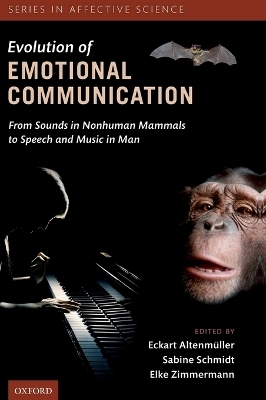
The Evolution of Emotional Communication
Oxford University Press (Verlag)
978-0-19-958356-0 (ISBN)
Why do we think that we can understand animal voices - such as the aggressive barking of a pet dog, and the longing meows of the family cat? Why do we think of deep voices as dominant and high voices as submissive. Are there universal principles governing our own communication system? Can we even see how close animals are related to us by constructing an evolutionary tree based on similarities and dissimilarities in acoustic signaling?
Research on the role of emotions in acoustic communication and its evolution has often been neglected, despite its obvious role in our daily life. When we infect others with our laugh, soothe a crying baby with a lullaby, or get goose bumps listening to classical music, we are barely aware of the complex processes upon which this behavior is based. It is not facial expressions or body language that are affecting us, but sound. They are present in music and speech as "emotional prosody" and allow us to communicate not only verbally but also emotionally.
This groundbreaking book presents a thorough exploration into how acoustically conveyed emotions are generated and processed in both animals and man. It is the first volume to bridge the gap between research in the acoustic communication of emotions in humans with those in animals, using a comparative approach. With the communication of emotions being an important research topic for a range of scientific fields, this book is valuable for those in the fields of animal behaviour, anthropology, evolutionary biology, human psychology, linguistics, musicology, and neurology.
Prof. Dr. med. Eckart Altenmüller (b. 1955) holds a Masters degree in classical flute, and is a Medical Doctor. After clinical training as a neurologist and habilitation, he became in 1994 chairman and director of the Institute of Music Physiology and Musicians' Medicine at the University of Music, Drama, and Media in Hannover. He continues research into the neurobiology of emotions and into movement disorders in musicians as well as motor, auditory and sensory learning. Since 2005 he is President of the German Society of Music Physiology and Musicians' Medicine and Member of the Göttingen Academy of Sciences. Privatdozent Dr. rer nat. Sabine Schmidt is an experimental behavioural and sensory biologist and Head of the Sensory Biology group of the Institute of Zoology at the University of Veterinary Medicine and the Centre for Systems Neuroscience in Hannover, Germany. Her main research interests cover behavioural ecology and psychoacoustics, with special emphasis on echolocation and acoustic communication in bats. Prof. Dr. rer nat. Elke Zimmermann is an experimental behavioural and evolutionary biologist and Director of the Institute of Zoology and Professor at the University of Veterinary Medicine and the Center for Systems Neuroscience in Hannover, Germany. Her main research interests cover patterns, processes and mechanisms of primate adaptation, speciation and evolution, with special emphasis to the evolution of communication and cognition. She is spokesperson of the DFG-funded interdisciplinary Research Unit Acoustic communication of emotions in humans and nonhuman mammals.
PART A: INTRODUCTORY SECTION; PART B: DIFFERENT MAMMALIAN TAXA; PART C: NON-SPEECH HUMAN VOCALIZATIONS; PART D: HUMAN PROSODY; PART E: MUSIC; PART F: SUMMARY: WHERE TO GO?
| Erscheint lt. Verlag | 24.1.2013 |
|---|---|
| Reihe/Serie | Series in Affective Science |
| Verlagsort | Oxford |
| Sprache | englisch |
| Maße | 185 x 246 mm |
| Gewicht | 824 g |
| Themenwelt | Geisteswissenschaften ► Psychologie ► Entwicklungspsychologie |
| Geisteswissenschaften ► Psychologie ► Sozialpsychologie | |
| Naturwissenschaften ► Biologie ► Evolution | |
| Naturwissenschaften ► Biologie ► Zoologie | |
| ISBN-10 | 0-19-958356-0 / 0199583560 |
| ISBN-13 | 978-0-19-958356-0 / 9780199583560 |
| Zustand | Neuware |
| Haben Sie eine Frage zum Produkt? |
aus dem Bereich


